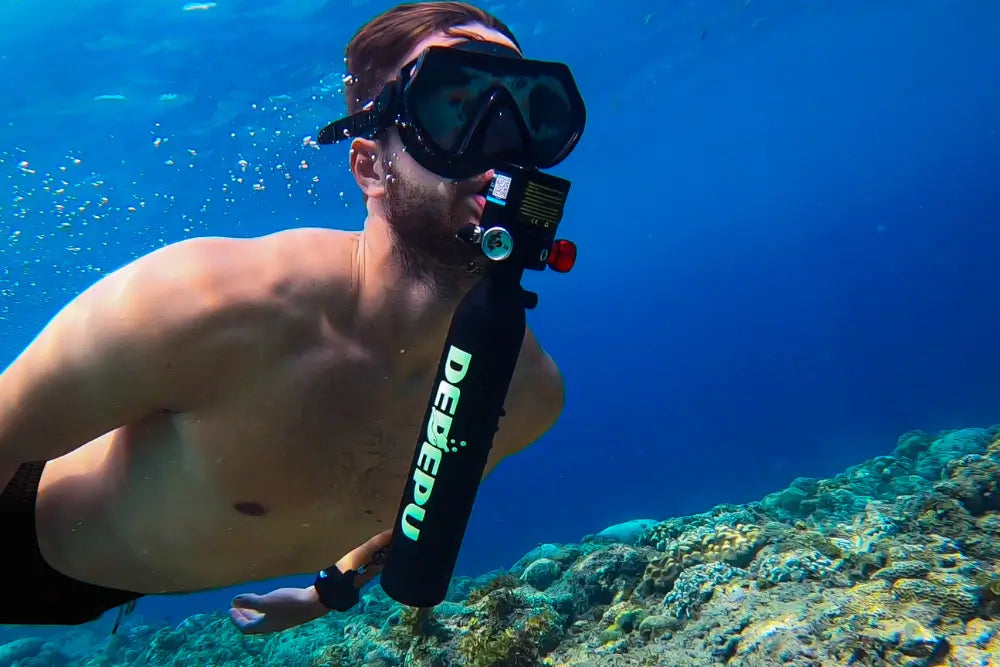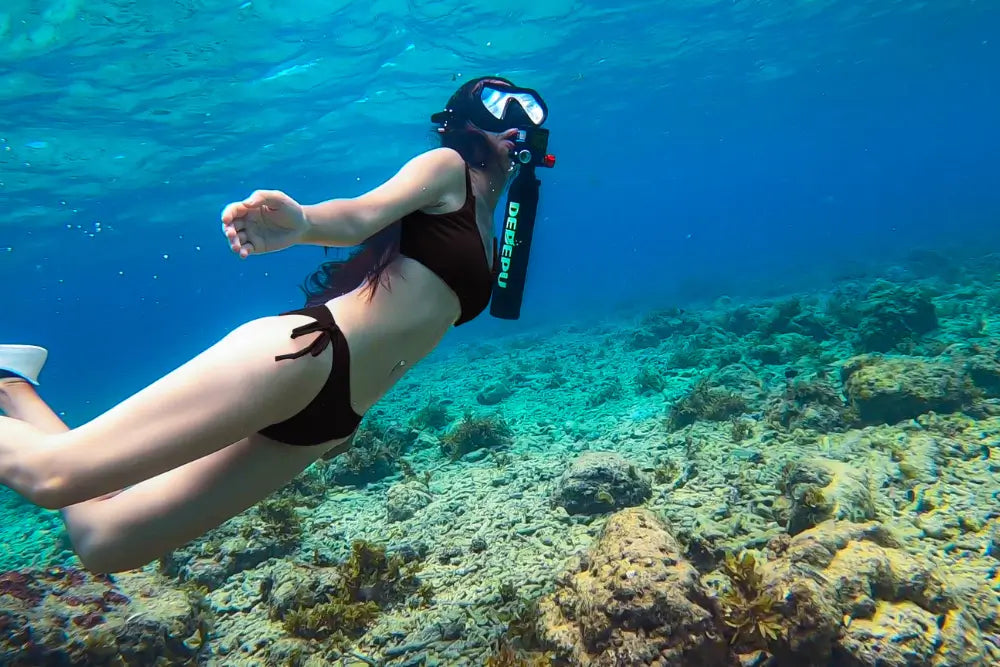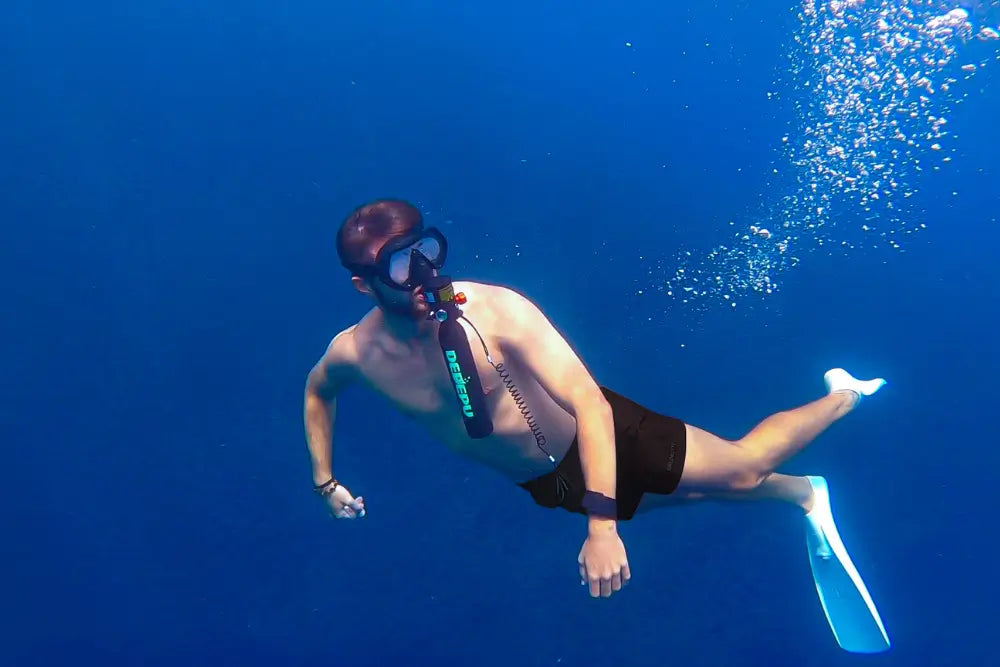<1 injury occurs per 200,000 dives when protocols are followed (DAN 2024), making it statistically safer than jogging. You don’t need Olympic swimming skills: certification requires treading water for 10 minutes + swimming 200m. Starter costs are reasonable: PADI Open Water courses average 800, and rentals run 80/day. Crucially, shallow dives aren’t inherently safe – 38% of incidents occur below 30ft (9m) due to currents or poor visibility. For best views, dive stable tropical sites in dry seasons, where visibility exceeds 35m (115ft). Always complete safety stops at 5m (15ft) for ≥3 minutes.
Diving is highly dangerous and accident-prone
While diving feels risky to beginners, data shows it’s statistically safer than driving or jogging when done right. According to DAN (Divers Alert Network), serious incidents occur in just 0.0005% of dives – roughly 1 injury per 200,000 dives – primarily when divers ignore protocols. Modern gear reliability plays a huge role: Regulators undergo 25,000+ pressure-test cycles during manufacturing, and buoyancy compensators (BCDs) last ~10 years with annual maintenance costing 100. Crucially, 90% of accidents involve diver error, like exceeding depth limits or skipping safety stops. Certified divers who complete 20+ logged dives see their incident probability drop below 0.0002%.
Entry-level courses (e.g., PADI Open Water) require ~24 hours of instruction, split between 6 confined-water drills and 4 open-water dives. Trainees practice emergency skills – like air-sharing at 15–20 feet (4.5–6 meters) – until response times fall under 5 seconds. Post-certification, divers with 30–50 logged dives halve their air consumption rate to ~15–20 liters per minute, allowing safer margins when navigating currents at 60–80 feet (18–24 meters).
A regulator serviced every 12 months or 100 dives sustains airflow rates of 1,200–1,600 liters/minute – triple human lung capacity. Dive computers, pressure-tested to 330 feet (100 meters), track ascent speeds to <30 feet (9 meters) per minute, reducing decompression sickness risk. Computers sold post-2015 have >95% reliability over 500+ dives, with failure rates spiking only if battery voltages dip below 2.7V.
Divers planning a 60-foot (18-meter) reef dive calculate max bottom time using NOAA tables: At that depth, no-deco limits are 55 minutes before mandatory stops. If water temp drops to <64°F (18°C), exposure protection shifts from 3mm wetsuits (effective for 45–60 mins) to 7mm suits or drysuits (safe for 75–120 mins). Currents above 1 knot (1.15 mph) require kicking power adjustments to conserve air – a skill automated in buoyancy tools like the ScubaPro Hydros Pro BC, which reduces drag by ~40% versus traditional jackets.
| Factor | Metric | Impact |
|---|---|---|
| Training Depth | 15–60 ft (4.5–18 m) in courses | Builds stress tolerance for 99% of recreational sites |
| Equipment Lifespan | Regulators: 10 yrs / Computers: 8 yrs | <0.1% failure rate if serviced annually |
| Air Efficiency | 600 psi reserve mandatory | Gives ~8–10 mins for controlled ascent at 30 ft |
| Visibility Safety | Min. usable range: 10 ft (3 m) | Triggers abort procedures if particles exceed 50mg/m³ density |

You need expert-level swimming skills to dive.
Industry data reveals that 95% of open-water certification agencies (PADI, SSI, NAUI) require only basic swim tests: tread water or float unassisted for 10 minutes, plus swim 200 meters (656 feet) without time limits – equivalent to 8 leisurely pool laps. Crucially, underwater movement relies on physics, not physical strength. A properly weighted diver with a buoyancy compensator (BCD) achieves neutral buoyancy at depths between 15–100 feet (4.5–30 meters) through micro-adjustments of just 0.5–1.0 psi air input, reducing kicking energy by ~70% versus surface swimming. Divers consume air at 12–18 liters/minute at rest (similar to yoga breathing), rising to 25–30 liters/minute in currents below 1 knot (1.15 mph), manageable for those sustaining a walking pace of 2–3 mph on land.
Training adapts equipment to human limits, with confined water drills conducted in pools just 6–12 feet (1.8–3.7 meters) deep, where instructors teach finning techniques that cut drag by 40–60% compared to freestyle swimming. Trainees practice gear removal/replacement in water temperatures ≥75°F (24°C) – proven to minimize muscle stiffness – and master buoyancy control using BCD inflation buttons rated for 2,500–5,000 press cycles, requiring finger pressure of <1.5 psi. Certification dives progress from 15-foot (4.5-meter) sand flats to 60-foot (18-meter) reefs, with safety stops at 15 feet (4.5 meters) lasting ≥3 minutes, achievable by individuals burning merely 5–7 kcal/min (comparable to slow cycling).
Modern fins leverage hydrodynamic curvature angles of 20–30 degrees, amplifying thrust by 120–150% per kick versus bare feet. Masks with low-volume designs (150–200 ml) clear water in ≤1 second with exhales of 0.5 liters of air. For reference, drowning risk in saltwater requires inhaling >1.5 liters, but regulators deliver air within 0.3 seconds at inhalation efforts of 0.8–1.0 inches H₂O, exceeding the average human inspiratory flow rate of 30–90 liters/min.
At 30 feet (9 meters), a diver weighing 155 lbs (70 kg) experiences effective weight reduced to ~14 lbs (6.3 kg) by displacement, allowing movement with leg forces of <20 Newtons (light walking). Air consumption stabilizes after 15–20 dives – novices initially use 25–35 liters/min, but habits like slow exhalations cut rates to 15–18 liters/min, supporting 45–60-minute dives with standard aluminum 80 tanks (77 ft³ capacity). When currents reach 1.5 knots, divers deploy surface marker buoys weighing 8–14 oz (225–400g), exerting drag forces of ≤0.5 lbs (2.2 N) during deployment, which falls within the 50th percentile grip strength range of adult women (58–70 lbs force).
Diving costs a fortune to start.
Entry-level programs like PADI’s Discover Scuba start at 150–250, including 60–90 minutes of pool training and a guided shallow dive (≤12 ft/3.6 m) with full gear. Rental packages average 45–80/day for regulator, BCD, tank, and computer–roughly 30–50% of retail (e.g., Aqua Lung Mikron regulator at 699) or Cressi Start BCD (349). For budgeting, 350–500, covering instruction, gear, and boat fees–parallel to a weekend ski trip costing 400+ for lift tickets and rentals. Annual dive travel surveys confirm >60% of beginners spend <$1,000 total in their first year by choosing rentals and local shore dives over expeditions.
PADI eLearning costs 185–250 and requires 4–6 hours online coursework to reduce in-person time to ≈16 hours confined water training. Instructors then train groups of 3–6 students simultaneously, sharing boat/gear overheads – driving tank rental down to 10–15 per aluminum-80 cylinder, which holds 77 cu ft of air filled at 3,000 psi (207 bar) for 45–60 minutes of bottom time at depths <40 ft (12 m). Crucially, entry-level masks cost 40–70 (e.g., Cressi F1) with fog-resistant coatings lasting 200+ dives, avoiding premium brands charging $150+ for similar silicone volume under 110 ml.
Gear rental economics protect beginners: Dive shops lease regulators at 15/day despite the unit’s 699 MSRP, leveraging 3-year service cycles where diaphragms get replaced every 150 dives at 20 per rebuild kit. A BCD rented 30 days/month pays off its 349 cost within 8–10 months, passing savings to customers. Computers like the Suunto Zoop Novo track dives to 150 ft (45 m) and rent for 20/day, operating reliably for ≥5 years/1,000 dives on CR2450 batteries (4, changed biennially) – smarter than sinking $450 immediately.
Geography drastically cuts expenses: Shore diving in Hawaii reduces boat fees to 0, with tanks filled for 10–12. Tropical sites (Honduras, Philippines) operate certification in 27–29°C (80–84°F) water, eliminating need for wetsuits thicker than 3mm (30/week rental). Compare to cold regions: California drysuit dives require 150–200/day rentals. Airfare analysis shows 70% of EU divers book 200 flights to Egypt vs. 2,000 Caribbean trips, cutting total trip costs to < $800 for 6 days diving.
Maintenance costs are predictable: Servicing a regulator annually costs 80–120, adding 7–10 years to its 15-year product lifespan. BCDs require 50 inspections after every 100 saltwater dives to replace corroded dump valves (14 each). Divers log <20 dives/year save 45% on maintenance versus enthusiasts doing 75+ dives.

Shallow water diving is always safe.
38% of diving incidents documented by DAN (Divers Alert Network) occur at depths ≤30 feet (9 meters), proving visibility and currents matter more than depth alone. A 5-foot (1.5-meter) sandy shelf can generate rip currents exceeding 2 knots (2.3 mph) during tide changes – force strong enough to push divers 300+ feet (91 meters) off-course in <90 seconds if unmanaged. Water clarity degrades exponentially near shore: River-fed sites average 6–10 feet (1.8–3 meters) visibility versus 60+ feet (18+ meters) offshore, creating collision risks with submerged rocks within 2–4 feet (0.6–1.2 meters) of the surface. Marine hazards like fire coral thrive at 3–15 foot (1–4.5 meter) depths, with stings causing ~72 hours of localized inflammation when contacting exposed skin.
When waves >3 feet (0.9 meters) hit slopes shallower than 10 degrees, water accelerates to 4–6 mph (1.8–2.7 m/s) across <10 feet (3 meters) of depth – a surge force of 150+ Newtons that destabilizes divers weighing <100 lbs (45 kg) in gear. Even in calm 1-knot currents, a diver kicking at 0.5 mph (0.2 m/s) drifts 88 feet (27 meters) during a 2-minute safety stop. Temperature stratification matters: Surface layers at 84°F (29°C) can plunge to 68°F (20°C) at 25 feet (7.6 meters) in thermoclines, triggering cold shock reflexes consuming 15–25 liters/min of air – 40–50% above normal rates.
Regulators free-flow 3× more frequently in ≤15 feet (4.5 meters) due to pressure differentials under 0.5–1.0 bar between tank pressure (200–230 bar) and ambient pressure (1.5 bar at 10ft/3m), releasing airflow bursts of >1,000 liters/min. BCDs require micro-inflation adjustments of ≤0.2 psi to maintain neutral buoyancy – precision compromised if depth varies ±2 feet (0.6 meters) in surf zones. Dive computers lose <0.5% accuracy on ascent rates above 60 ft/min (18 m/min), critical when ascending from 20 to 5 feet (6–1.5 meters) where pressure drop doubles.
Environmental variables demand quantification:
Visibility Thresholds: Minimum operational clarity is 10 feet (3 meters) – below which navigation errors spike 300% per accident reports
Thermal Exposure: In 68°F (20°C) water, a 3mm wetsuit provides insulation for ≤45 minutes before core temperature drops 1.8°F (1°C), impairing motor skills
Marine Hazards: Urchins spines penetrate 0.4 inches (10mm) through neoprene thinner than 3mm, with injury rates 5× higher in ≤15ft (4.5m) rocky zones
Procedural safeguards mitigate shallow threats: Divers in ≤20 feet (6 meters) deploy surface marker buoys (SMBs) within ≤15 seconds if visibility falls below 10 feet (3 meters) or current exceeds 1 knot (0.5 m/s). Shore entries are restricted to wave heights <2 feet (0.6 meters) and periods >8 seconds – conditions where wave force drops below 20 kg/m². Teams practice “touch contact” communication maintaining <3 feet (0.9 meters) separation when particulate density exceeds 500 particles/mL.

Underwater scenes are consistently crystal-clear
Tropical reefs average 60–100 ft (18–30 m) clarity in dry seasons, but monsoon rains slash it to 15–25 ft (4.5–7.6 m) as rivers dump >200 mg/L sediment. Coastal sites suffer worse: California’s kelp forests fluctuate between 5–40 ft (1.5–12 m) visibility daily due to tidal plankton blooms peaking at ≥500,000 cells/mL. Even crystal destinations like the Maldives see 30% seasonal drops – southwest monsoons (May-Nov) churn 2–4 ft (0.6–1.2 m) waves, suspending sand that cuts visibility to 40 ft (12 m) from December’s 100 ft (30 m). Physics dominates: Light absorption removes 60% of red wavelengths at 33 ft (10 m), turning vibrant coral into murky blue-gray shapes beyond 65 ft (20 m). Your eyes resolve details only within 10x visibility range – at 30 ft (9 m) clarity, a shark 30 ft away appears as a vague shadow.
Environmental Triggers Alter Clarity Hourly
When tidal currents exceed 0.8 knots (0.4 m/s), they resuspend ≥50 g/m³ sand from bottoms shallower than 40 ft (12 m), cutting visibility by 45–70% within 20 minutes. River plumes inject dissolved organic matter (DOM) at concentrations >5 mg/L, scattering light and reducing visibility to <10 ft (3 m) up to half a mile offshore. Phytoplankton blooms spike when water hits 62–68°F (17–20°C), with diatom densities exceeding 1 million cells/L – turning water into “pea soup” with <6 ft (1.8 m) visibility. Rainfall compounds this: 1 inch (25 mm) of rain washes ~200 tons of silt/km² into coastal zones, increasing turbidity by 40 NTU (Nephelometric Turbidity Units) and halving visibility for 12–48 hours.
Gear Limitations in Real Conditions
Masks fog from condensation at humidity >85% inside the lens – a near-constant state underwater – reducing acuity by 30% until defogged. Camera housings rated for 150 ft (45 m) suffer 50% light loss at 33 ft (10 m) unless strobes output >10,000 lumens within 2 ft (0.6 m) range. GoPro Hero 11’s low-light mode fails at particle densities >100 mg/m³, capturing only 15% of true colors versus 72% in Caribbean shallows. Dive computers display depth errors up to ±3 ft (0.9 m) in silt clouds where sensor resolution drops below 0.5 ft (0.15 m).
Human Vision Constraints Underwater
Light attenuation removes red/orange wavelengths at depths >15 ft (4.5 m) at rates of 1.5% per foot (0.3 m) – coral at 50 ft (15 m) appears 80% desaturated without artificial lights. Human eyes resolve details at 1 arc-minute resolution – meaning in 20 ft (6 m) visibility, a 3 ft (0.9 m) wide fish becomes unrecognizable beyond 60 ft (18 m) distance. Pupil dilation in low light (below 10 ft-candles) reduces visual acuity to 20/80 or worse below 65 ft (20 m) – equivalent to driving without glasses.
| Situation | Tactical Response | Data Threshold |
|---|---|---|
| Silt Out | Abort if <3 ft viz | Particle density >250 mg/m³ |
| Low Light | Deploy 10,000-lumen lights | Depth >40 ft (12 m) + <1% surface illumination |
| Current Suspension | Hug bottom at ≤5° slope | Flow >1 knot (0.51 m/s) |
| Bio-Overload | Avoid diving May-Sep in tropics | Phytoplankton >500k cells/L |





Dejar un comentario
Todos los comentarios se revisan antes de su publicación.
Este sitio está protegido por hCaptcha y se aplican la Política de privacidad de hCaptcha y los Términos del servicio.